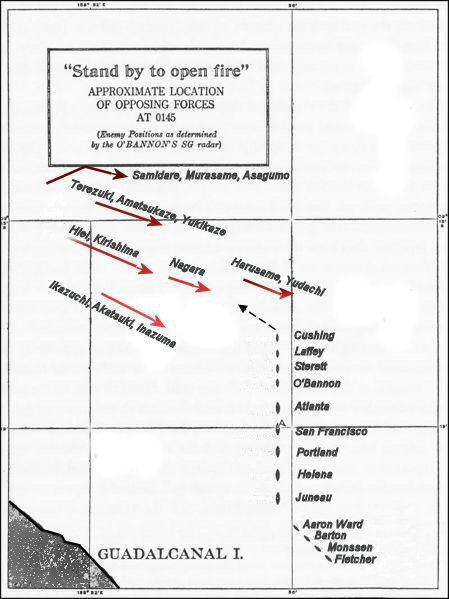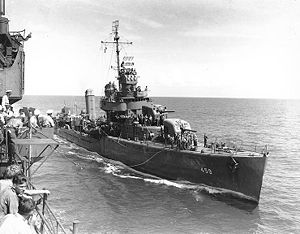John Robert Green, the 2nd cousin of Inez Merle Eyl Martfeld, served as a Torpedoman First Class (TM1c) aboard the USS Laffey (DD-459) from her commissioning on 31 March 1941 in San Francisco Bay until her sinking at Guadalcanal on the night of 13 November 1942. John Robert Green was undoubtedly busy that night as Laffey engaged at least 4 Japanese war ships with torpedos and 5 inch guns. Below is an excert from a document authored by E. Andrew Wilde, Jr. (see the Destroyer History Foundation for the complete document):

On the inky-dark night of 13 November 1942, USS Laffey followed in the wake of USS Cushing, proceeding up “The Slot”. The Japanese had set an ingenious trap to catch the audacious little United States force; they came with battleships, cruisers, and destroyers.
USS Laffey, never reticent in attack, left a Japanese destroyer burning and dead in the water in the first three minutes of the battle that followed. She then tackled a Japanese cruiser and, though the cruiser hurled 8-inch shells, Laffey’s smaller 5-inch guns, soon silenced the guns of the cruiser and left her dead in the water, ravaged and burning.
Laffey still didn’t have to look for a target. Like a nightmare, the skyscraper-pagoda mast of a Japanese Kongo-class battleship loomed through the darkness, coming toward the destroyer at 25 knots. Laffey closed the monstrous man-o-war at full speed. A salvo of torpedoes were fired. At the last moment, Laffey was turned just enough to clear the bow of the enemy, and no sooner had she cleared than her guns began to speak at point-blank range. The enemy battleship’s superstructure was literally pulverized. Two of Laffey’s torpedoes also found their mark as the white glare of the explosion crawled up the side of the big battleship.
As Laffey ran further and further ahead of the American line of ships, she soon found herself in the center of a ring of enemy ships. Simultaneously, two Japanese destroyers opened fire on her, the nearest knocking out two of her 5-inch guns. Laffy’s answer to this was another salvo of torpedoes toward the nearest Japanese destroyer. Maneuvering violently, the enemy destroyer managed to evade all but one torpedo, but that left another ship dead and burning.
With her three remaining 5-inchers blazing in rage, Laffey turned on the remaining foe, one of the big Kagero class destroyers. Two-thirds again as large as Laffey, the Japanese destroyer started to pound the now thoroughly exausted Laffey. At point blank range the two ships duelled, circling each other in a fight to the death. Slowly they disintegrated before the other’s withering fire. Another 5-inch gun of Laffey’s was silenced and yet another until she was down to her last 5-inch gun. That one gun doggedly keep barking and at the time when all seemed lost, a flame, preceeded by a brilliant flash, shot skyward and in its light the men of the Laffey could see the Japanese ship tear apart and sink into the blackness of the deep.

Now, the big Jap battleship, whose bridge Laffey had so completely demolished, began to assert herself. Alone in the darkened sea, engines disabled and fires raging out of control, there was no escape for Laffey. Commanding officer Hank gave the last order: “Abandon Ship”…
This account clearly demonstrates the heroics and bravery of the USS Laffey crew. TM1c John Robert Green gave his life that night in one of the most grueling sea battles of World War II. John’s remains were unrecoverable and so he remains with USS Laffey at the bottom of Iron Bottom Sound.
Visit TM1c John Robert Green’s individual record.
Credits:
- Wikipedia, Naval Battle of Guadalcanal, Accessed July 23, 2020. https://en.wikipedia.org/wiki/Naval_Battle_of_Guadalcanal
- Wikipedia, USS Laffey (DD-459), Accessed Nov 23, 2019. https://en.wikipedia.org/wiki/USS_Laffey_(DD-459)
Let us never forget.
